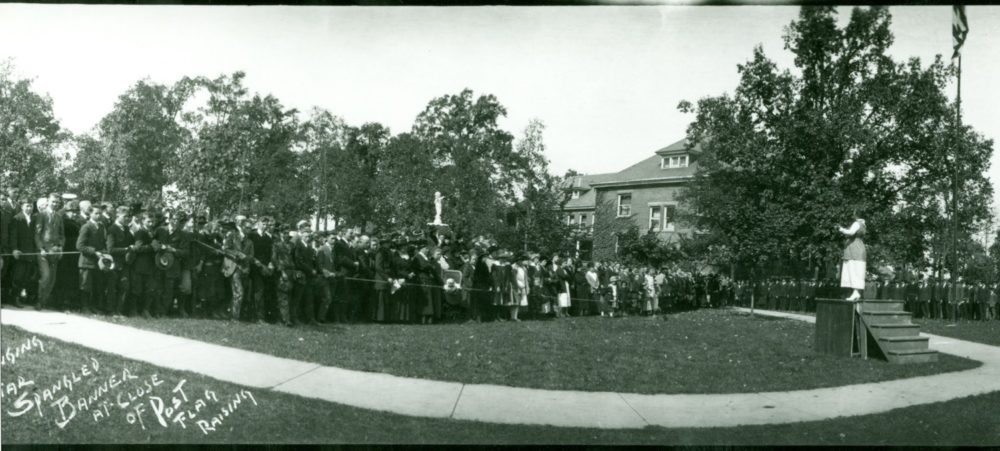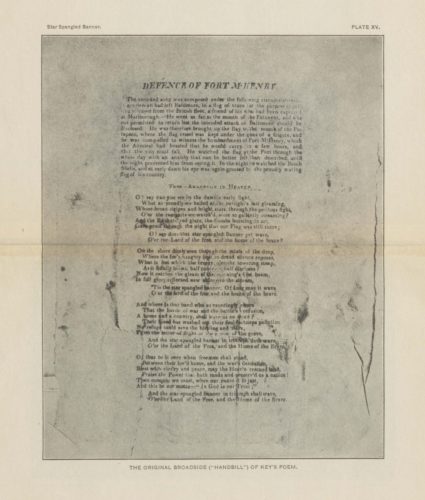Our Flag Was Still There: Francis Scott Key and the “Star-Spangled Banner”

On September 7, 1814, American attorney Francis Scott Key boarded the British ship HMS Tonnant, which was anchored just in the Baltimore harbor, hoping to negotiate the release of prisoners being held during the War of 1812. His negotiations were successful, but his timing – the British were in the midst of planning an attack on Fort McHenry – meant that he was held on the ship for a full week… and led to the composition of what would become the national anthem of the United States: the “Star-Spangled Banner.”

The poem, “Defence of Fort M’Henry,” was not Key’s first foray into poetry, but it was certainly his most memorable. This was also not the first time Key set a poem to this particular song; in 1805, Key wrote “When the Warrior Returns” about the First Barbary War and naval hero Stephen Decatur and used the same tune (more on that in a moment) as well as some of the same words, to create a song of patriotism and glory. For example, “brows of the brave” became “home of the brave,” and the phrase “star spangled flag” was revised to “star spangled banner.” To read “When the Warrior Returns,” visit Poem of the Week here (please note that clicking the link will take you to a site that is not affiliated with Ohio Memory).
Key also recycled the tune to which he set his poems, choosing “To Anacreon in Heaven” for both. Interestingly, “To Anacreon in Heaven” was originally a British drinking song, containing bawdy lyrics that were undeniably suitable for belting out in a pub (to read the lyrics at Poem of the Week, click here). You might wonder why Francis Scott Key chose the tune of a drinking song for these two decidedly serious poems. The Baltimore Sun suggests that it was not the original tune that Key was thinking of when he wrote his verses but, more likely, another song, also patriotic, also using the same tune, that inspired Key: “Adams and Liberty,” written in 1798 by Robert Treat Paine (you can read that poem here at Poem of the Week).
In 1914, for the centennial of the “Star-Spangled Banner,” the Library of Congress published a history of the song and included an investigation into the history of “To Anacreon in Heaven.” The author, Oscar George Theodore Sonneck, was the head of the music division at the Library from 1902 to 1917, and specialized in the history of early American music. His publication is entertaining and his wit and humor are on display throughout the piece. He doesn’t hesitate to mockingly challenge other researchers whose conclusions he finds weak, calling one investigation “one of the most grotesquely absurd articles in musical literature.” Snark in a government publication? Fun! You can read the piece here, and I highly recommend it.
You can also read a number of Key’s poems in the book Poems of the Late Francis S. Key, Esq. You’ll see the “Star-Spangled Banner,” “When the Warrior Returns,” and other patriotic writings, but you’ll also see poems written about locations he visited or dedicated to family members, such as this one entitled “To my Cousin Mary, for Mending My Tobacco Pouch,” which begins:
My conscience has given me several twitches
For not having thanked my fair coz. for her stitches;
The pouch that contains the best part of my riches
She has made safe and sound by her excellent stitches.
For more information on the flag that inspired Key, we highly recommend the Smithsonian Museum of American History’s pages (note: link will take you to a site separate from Ohio Memory) dedicated to the flag itself, including its restoration, and to the history of Key’s song. You can even take a quiz and earn a certificate!
Thank you to Shannon Kupfer, Digital Initiatives Librarian at theState Library of Ohio, for this week’s post!



Leave a Reply
You must be logged in to post a comment.